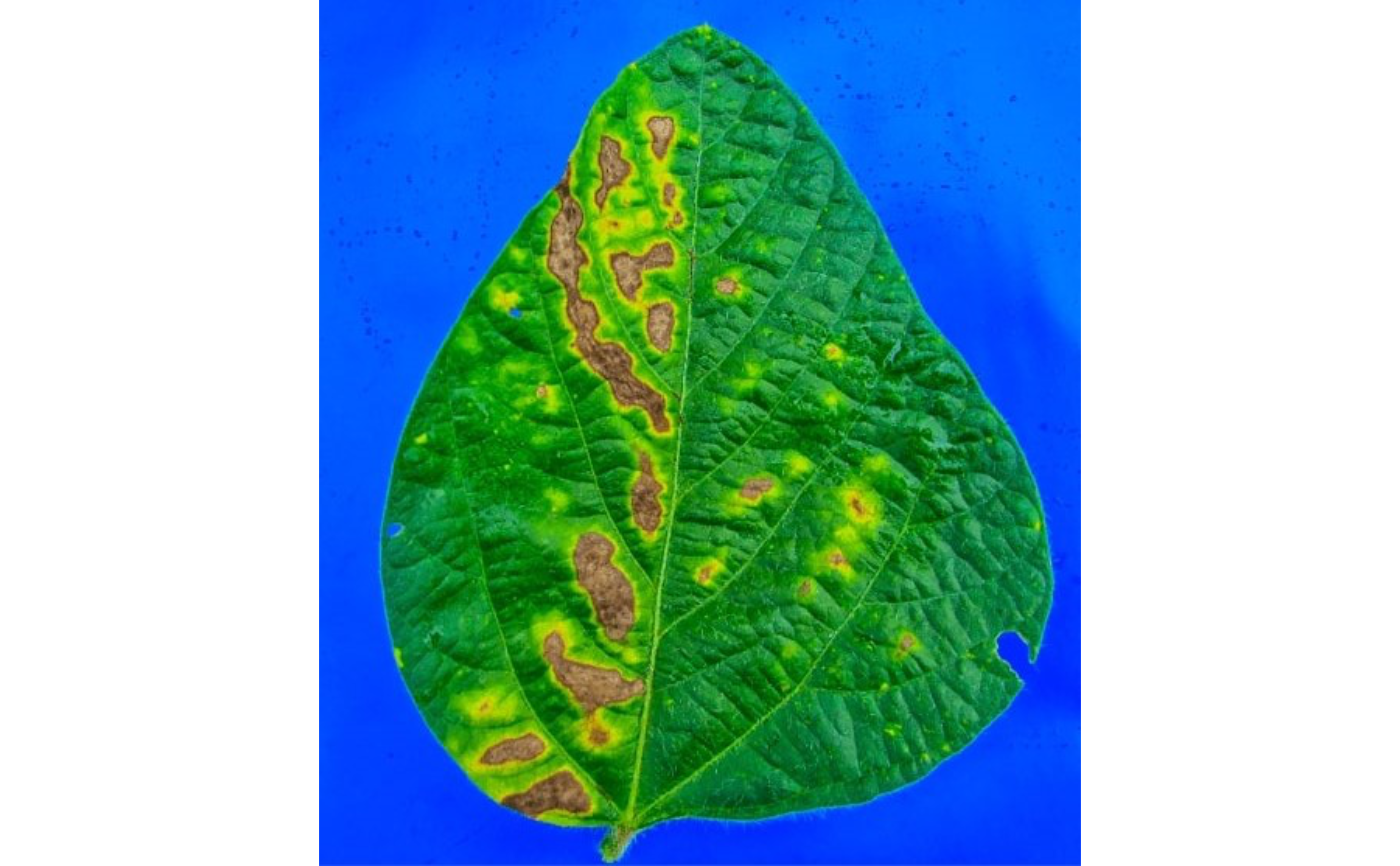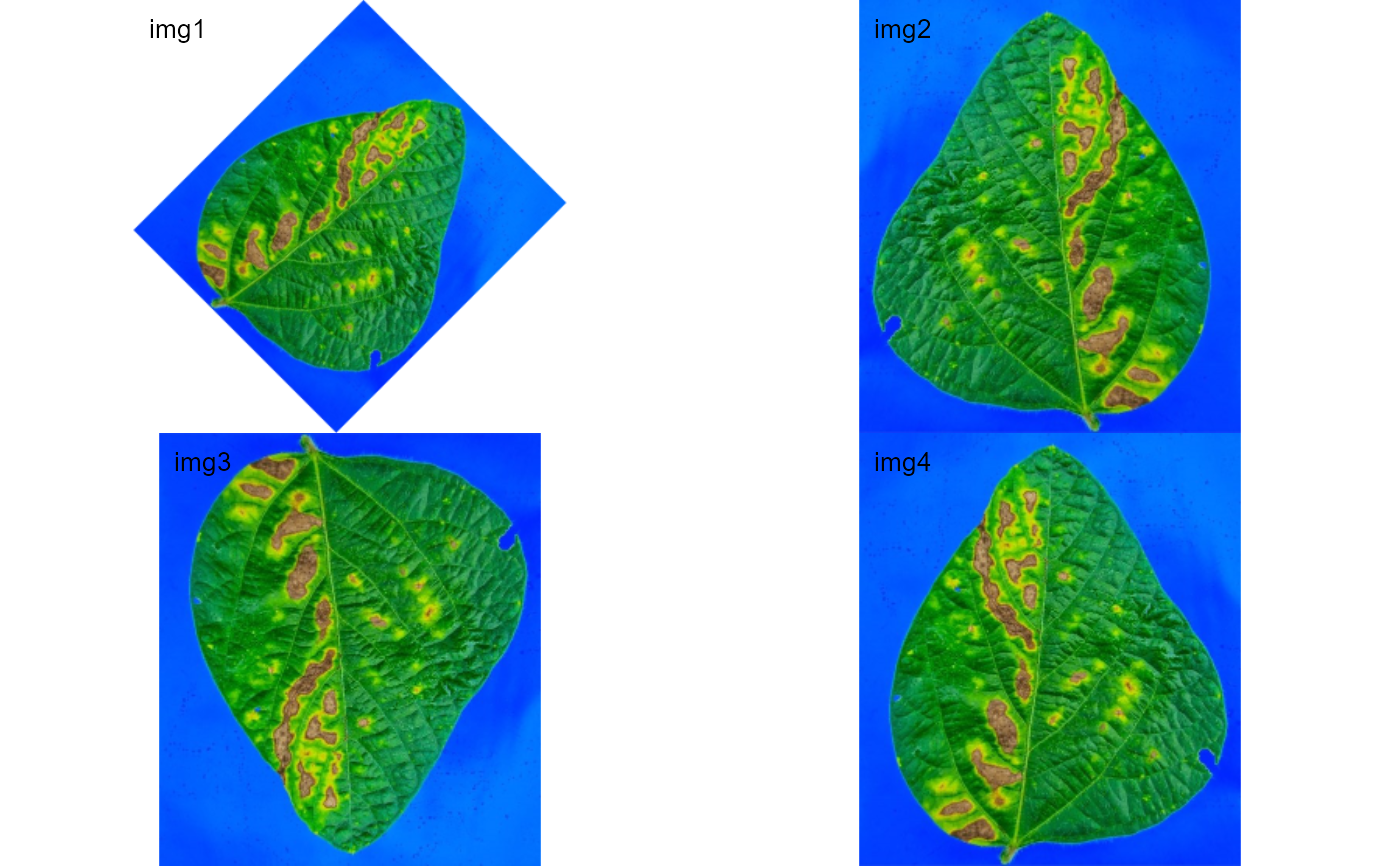Performs image rotation and reflection
image autocrop()Crops automatically an image to the area of objects.image_crop()Crops an image to the desired area.image_trim()Remove pixels from the edges of an image (20 by default).image_dimension()Gives the dimension (width and height) of an image.image_rotate()Rotates the image clockwise by the given angle.image_horizontal()Converts (if needed) an image to a horizontal image.image_vertical()Converts (if needed) an image to a vertical image.image_hreflect()Performs horizontal reflection of theimage.image_vreflect()Performs vertical reflection of theimage.image_resize()Resize theimage. See more atEBImage::resize().image_contrast()Improve contrast locally by performing adaptive histogram equalization. See more atEBImage::clahe().image_dilate()Performs image dilatation. See more atEBImage::dilate().image_erode()Performs image erosion. See more atEBImage::erode().image_opening()Performs an erosion followed by a dilation. See more atEBImage::opening().image_closing()Performs a dilation followed by an erosion. See more atEBImage::closing().image_filter()Performs median filtering in constant time. See more atEBImage::medianFilter().image_blur()Performs blurring filter of images. See more atEBImage::gblur().image_skeleton()Performs image skeletonization.
Usage
image_autocrop(
img,
index = "NB",
edge = 5,
filter = 3,
parallel = FALSE,
workers = NULL,
verbose = TRUE,
plot = FALSE
)
image_crop(
img,
width = NULL,
height = NULL,
viewer = get_pliman_viewer(),
downsample = NULL,
max_pixels = 1e+06,
show = "rgb",
parallel = FALSE,
workers = NULL,
verbose = TRUE,
plot = FALSE
)
image_dimension(img, parallel = FALSE, workers = NULL, verbose = TRUE)
image_rotate(
img,
angle,
bg_col = "white",
parallel = FALSE,
workers = NULL,
verbose = TRUE,
plot = TRUE
)
image_horizontal(
img,
parallel = FALSE,
workers = NULL,
verbose = TRUE,
plot = FALSE
)
image_vertical(
img,
parallel = FALSE,
workers = NULL,
verbose = TRUE,
plot = FALSE
)
image_hreflect(
img,
parallel = FALSE,
workers = NULL,
verbose = TRUE,
plot = FALSE
)
image_vreflect(
img,
parallel = FALSE,
workers = NULL,
verbose = TRUE,
plot = FALSE
)
image_resize(
img,
rel_size = 100,
width,
height,
parallel = FALSE,
workers = NULL,
verbose = TRUE,
plot = FALSE
)
image_trim(
img,
edge = NULL,
top = NULL,
bottom = NULL,
left = NULL,
right = NULL,
parallel = FALSE,
workers = NULL,
verbose = TRUE,
plot = FALSE
)
image_dilate(
img,
kern = NULL,
size = NULL,
shape = "disc",
parallel = FALSE,
workers = NULL,
verbose = TRUE,
plot = FALSE
)
image_erode(
img,
kern = NULL,
size = NULL,
shape = "disc",
parallel = FALSE,
workers = NULL,
verbose = TRUE,
plot = FALSE
)
image_opening(
img,
kern = NULL,
size = NULL,
shape = "disc",
parallel = FALSE,
workers = NULL,
verbose = TRUE,
plot = FALSE
)
image_closing(
img,
kern = NULL,
size = NULL,
shape = "disc",
parallel = FALSE,
workers = NULL,
verbose = TRUE,
plot = FALSE
)
image_skeleton(
img,
kern = NULL,
parallel = FALSE,
workers = NULL,
verbose = TRUE,
plot = FALSE,
...
)
image_thinning(
img,
niter = 3,
parallel = FALSE,
workers = NULL,
verbose = TRUE,
plot = FALSE,
...
)
image_filter(
img,
size = 2,
cache = 512,
parallel = FALSE,
workers = NULL,
verbose = TRUE,
plot = FALSE
)
image_blur(
img,
sigma = 3,
parallel = FALSE,
workers = NULL,
verbose = TRUE,
plot = FALSE
)
image_contrast(
img,
parallel = FALSE,
workers = NULL,
verbose = TRUE,
plot = FALSE
)Arguments
- img
An image or a list of images of class
Image.- index
The index to segment the image. See
image_index()for more details. Defaults to"NB"(normalized blue).- edge
for
image_autocrop()the number of pixels in the edge of the cropped image. Ifedge = 0the image will be cropped to create a bounding rectangle (x and y coordinates) around the image objects.for
image_trim(), the number of pixels removed from the edges. By default, 20 pixels are removed from all the edges.
- filter
Performs median filtering in the binary image. This is useful to remove noise (like dust) and improve the image autocropping method. See more at
image_filter(). Set toFALSEto remove the median filtering.- parallel
Processes the images asynchronously (in parallel) in separate R sessions running in the background on the same machine. It may speed up the processing time when
imageis a list. The number of sections is set up to 70% of available cores.- workers
A positive numeric scalar or a function specifying the maximum number of parallel processes that can be active at the same time.
- verbose
If
TRUE(default) a summary is shown in the console.- plot
If
TRUEplots the modified image. Defaults toFALSE.- width, height
For
image_resize()the Width and height of the resized image. These arguments can be missing. In this case, the image is resized according to the relative size informed inrel_size.For
image_crop()a numeric vector indicating the pixel range (x and y, respectively) that will be maintained in the cropped image, e.g., width = 100:200
- viewer
The viewer option. If not provided, the value is retrieved using
get_pliman_viewer(). This option controls the type of viewer to use for interactive plotting. The available options are "base" and "mapview". If set to "base", the base R graphics system is used for interactive plotting. If set to "mapview", the mapview package is used. To set this argument globally for all functions in the package, you can use theset_pliman_viewer()function. For example, you can runset_pliman_viewer("mapview")to set the viewer option to "mapview" for all functions.- downsample
integer; for each dimension the number of pixels/lines/bands etc that will be skipped; Defaults to
NULL, which will find the best downsampling factor to approximate themax_pixelsvalue.- max_pixels
integer > 0. Maximum number of cells to use for the plot. If
max_pixels < npixels(img), regular sampling is used before plotting.- show
How to plot in mapview viewer, either
"rgb"or"index".- angle
The rotation angle in degrees.
- bg_col
Color used to fill the background pixels, defaults to
"white".- rel_size
The relative size of the resized image. Defaults to 100. For example, setting
rel_size = 50to an image of width1280 x 720, the new image will have a size of640 x 360.- top, bottom, left, right
The number of pixels removed from
top,bottom,left, andrightwhen usingimage_trim().- kern
An
Imageobject or an array, containing the structuring element. Defaults to a brushe generated withEBImage::makeBrush().- size
For
image_filter()is the median filter radius (integer). Defaults to3.For
image_dilate()andimage_erode()is an odd number containing the size of the brush in pixels. Even numbers are rounded to the next odd one. The default depends on the image resolution and is computed as the image resolution (megapixels) times 20.
- shape
A character vector indicating the shape of the brush. Can be
box,disc,diamond,Gaussianorline. Default isdisc.- ...
Additional arguments passed on to
image_binary().- niter
The number of iterations to perform in the thinning procedure. Defaults to 3. Set to
NULLto iterate until the binary image is no longer changing.- cache
The the L2 cache size of the system CPU in kB (integer). Defaults to
512.- sigma
A numeric denoting the standard deviation of the Gaussian filter used for blurring. Defaults to
3.
Value
image_skeleton()returns a binaryImageobject.All other functions returns a modified version of
imagedepending on theimage_*()function used.If
imageis a list, a list of the same length will be returned.
Author
Tiago Olivoto tiagoolivoto@gmail.com
Examples
library(pliman)
img <- image_pliman("sev_leaf.jpg")
plot(img)
 img <- image_resize(img, 50)
img1 <- image_rotate(img, 45)
img2 <- image_hreflect(img)
img3 <- image_vreflect(img)
img4 <- image_vertical(img)
image_combine(img1, img2, img3, img4)
img <- image_resize(img, 50)
img1 <- image_rotate(img, 45)
img2 <- image_hreflect(img)
img3 <- image_vreflect(img)
img4 <- image_vertical(img)
image_combine(img1, img2, img3, img4)

